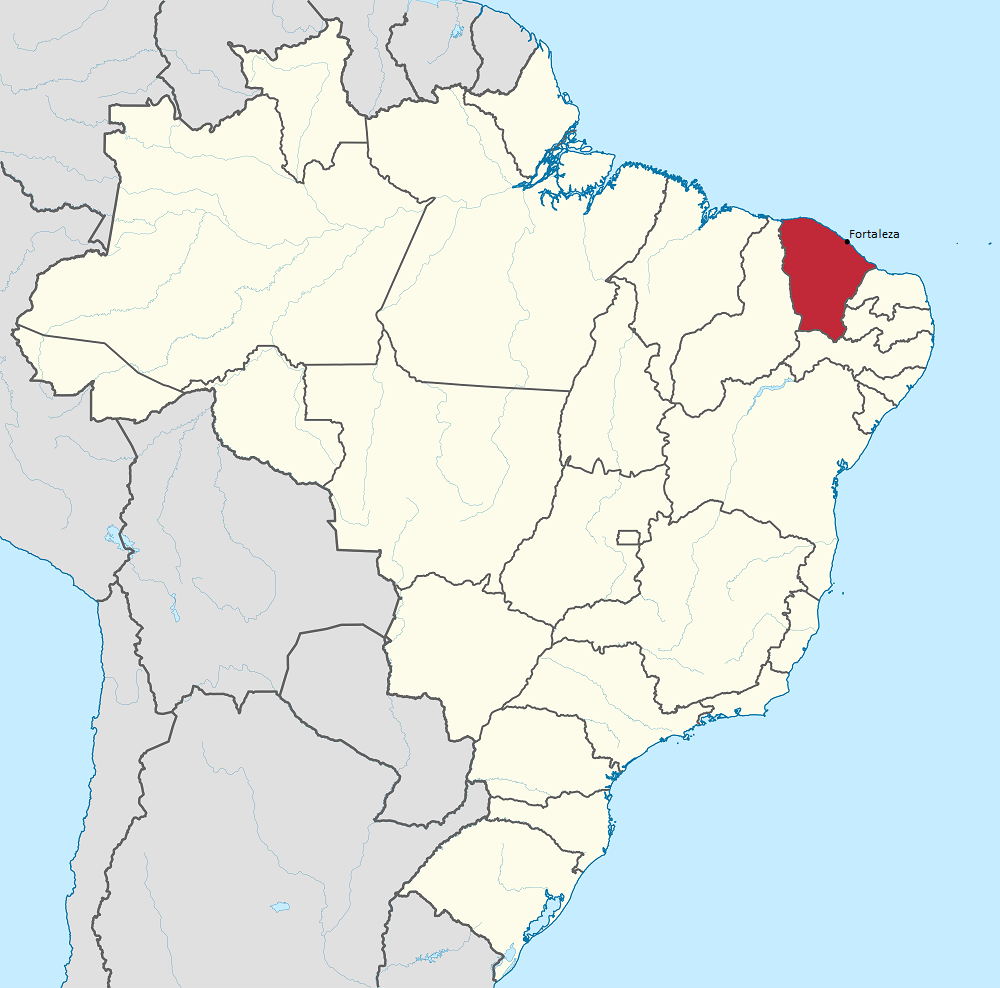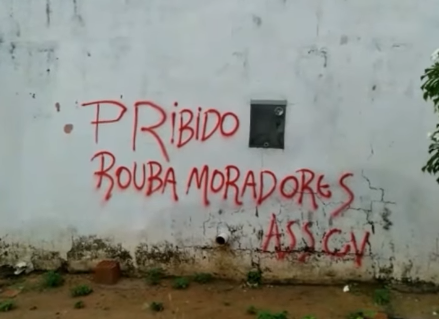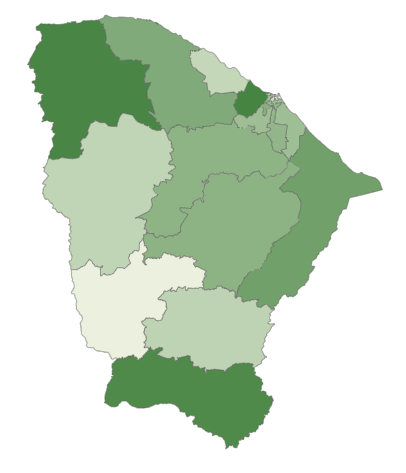SUMMARY
The state of Ceará, located in northeastern Brazil, is facing significant security challenges characterized by high levels of violent crime driven by conflicts among criminal factions involved in drug trafficking, particularly in Fortaleza. Recent trends show persistent crime rates, with Ceará having elevated number of violent deaths compared to other Brazilian states. While Rio de Janeiro and São Paulo have made notable progress in reducing violence, Ceará continues to struggle with these issues, with four cities ranking among Brazil’s most violent, including Maracanaú, which has the highest homicide rate in the State. This violence negatively impacts the tourism sector, deterring visitors and harming local businesses, although opportunities for economic growth exist in sectors like renewable energy.
State of Ceará
The state of Ceará, situated in the northeastern region of Brazil, is renowned for its stunning beaches, rich cultural heritage, and vibrant tourism industry. With a population of approximately 9.2 million people and a Human Development Index (HDI) of 0.735 (IBGE-2022), Ceará encompasses diverse communities and landscapes, ranging from its coastal capital, Fortaleza, to its arid hinterlands. The state’s economy is primarily driven by tourism, agriculture, and industry, with key sectors including renewable energy, particularly wind and solar power. Ceará’s strategic position as a logistics hub for international trade has also significantly bolstered its economic development.

However, Ceará has been grappling with a precarious security situation in recent years. The state has seen an alarming rise in violent crimes, including homicides and robberies, largely driven by clashes between criminal factions vying for control of drug trafficking. This wave of violence has particularly affected Fortaleza, which now ranks among the most violent urban centers in the country.
Criminal Factions Operating in Ceará
With the presence of seven criminal factions engaged in competition for control over drug trafficking routes and territories, the state is facing acts of extreme violence, as highlighted by the Secretary of Public Security of Ceará, Roberto Sá. In June of this year, one of the most brutal acts was recorded with the massacre of eight people in a public square in Viçosa. The following night, the Barroso neighborhood in Fortaleza witnessed another violent attack, with a woman and a 10-year-old child being murdered on a football field, in addition to several other victims between the ages of 8 and 16 being shot. These crimes were attributed to an emerging group in the state known as Mass (Massa), Prison Mass (Massa Carcerária), Everything Neutral (Tudo Neutro/TDN), formed by former members pr the Red Command (Comando Vermelho/CV) criminal gang.


Groups such as the CV and it main rival, the First Capital Command PCC (Primeiro Comando da Capital), have settled in Ceará, attracted by the state’s strategic position for international drug trafficking, due to its proximity to Europe and Africa and access to ports such as Pecém and Mucuripe. In addition, the creation of a local faction, the Guardians of the State (Guardiões do Estado/GDE), in 2016, intensified territorial confrontations by resisting the advance of external factions and seeking to impose their dominance on the outskirts of Fortaleza and other urban areas.
This violence is not a recent phenomenon but reflects a historical trajectory that dates back to the 1990s, when Ceará consolidated itself as a strategic route for drug trafficking. The entry of the PCC in 2006 and the consequent expansion of the CV triggered a turf war that, over the years, contributed to the increase in homicide rates. Since then, new local factions such as the Guardians of the State have emerged and internal disputes within the CV have given rise to the Everything Neutral. Even with police operations to try to contain crime, homicide rates remain high, and the environment of insecurity is aggravated by socioeconomic factors such as poverty and low levels of education.
Analysis of Violence Statistics
In recent years, violence has intensified in Ceará, placing the state in a negative spotlight in national crime rankings. In the first quarter of 2024, Ceará recorded the second-highest murder rate per 100,000 inhabitants in Brazil, according to data from the National Public Security Information System (Sinesp) of the Ministry of Justice and Public Security (MJSP). The state registered 819 Intentional Lethal Violent Crimes (Crimes Violentos Letais Intencionais)—which include intentional homicides, femicides, robberies resulting in death, and bodily injuries followed by death—during the first three months of 2024, leading to a CVLI rate of 37.25 per 100,000 inhabitants. Only Pernambuco had a higher rate, with a rate of 43.71 CVLIs per 100,000 inhabitants.

Among the capitals, Fortaleza had the third-highest number of murders in absolute terms, with 223 CVLIs from January to March 2024, falling behind only Recife (224) and Salvador (253). Caucaia, in the Metropolitan Region of Fortaleza, was the second city in Ceará with the most homicides, registering 78 cases and ranking 10th in the national list of murders in absolute numbers.

The violence in Ceará continued to worsen in 2024. April marked a particularly grim milestone, with 320 murders, making it the most violent month in the state since November 2020, when 343 homicides were recorded. The overall analysis of the first four months of 2024 shows an increase in violent deaths compared to previous years: there were 1,080 deaths from January to April 2021, 998 in the same period in 2022, and 947 murders between January and April 2023.

From May to September 2024, a concerning continuity of violence was observed in Ceará, set against an already alarming backdrop. In May, there were 316 recorded CVLIs, representing a slight decrease compared to the previous month, April, which registered 320 deaths.
The numbers begin to show a trend of reduction over the following months, with June recording 259 CVLIs, July with 246, and August with 254, and September with 231. Despite the improvements in such months, numbers are still high compared to previous periods, which means that Ceará continues to face a serious public safety challenge.
The Most Violent Cities in Ceará
Four cities in Ceará rank among the 50 most violent in Brazil based on homicide rates for cities with over 100,000 inhabitants, according to the 2024 Violence Atlas – which analyzes data from 2023. Maracanaú stands out as the city with the highest homicide rate in the state, holding the 18th position among all cities in the country, with an estimated rate of 58 homicides per 100,000 inhabitants. The other three cities included in the list are Caucaia, with a rate of 56.2; Sobral, at 48.3; and Fortaleza, which has a rate of 45.3.
Among the capitals, Fortaleza ranks as the fifth most violent city in Brazil. The cities with higher homicide rates than Fortaleza include Salvador, Macapá, Manaus, and Porto Velho. These figures highlight the critical public safety issues facing urban areas in Ceará and the urgent need for effective crime prevention measures. The study also indicates that Ceará has the second-highest estimated homicide rate in the Northeast, with a rate of 39.0 homicides per 100,000 inhabitants, only behind Bahia, whose rate is 46.8 per 100,000.
Violent Death Rates: Ceará, Rio, and São Paulo
The 2024 Public Security Yearbook, produced by the Brazilian Public Security Forum, provides a detailed overview of the Intentional Violent Deaths (IVD) rates across Brazil, enabling comparison between states. The IVD category includes intentional homicides, robbery-related murders, fatal physical assaults, and deaths resulting from police interventions. This metric provides a comprehensive view of intentional fatalities in each state, highlighting the unique challenges they face in tackling lethal violence.
In 2023, Ceará recorded 3,112 Intentional Violent Deaths (IVDs), with a rate of 35.4 deaths per 100,000 inhabitants, indicating a slight decrease of 0.4% from the previous year. This places Ceará among the states with the highest incidence of lethal violence, significantly above the national average of 22.8. In contrast, São Paulo reported 3,481 deaths and a rate of 7.8 per 100,000 inhabitants, reflecting a 6.9% reduction from 2022 and the lowest rate among the three states compared. Meanwhile, Rio de Janeiro, despite a notable decrease of 4.8% in occurrences, still recorded a rate of 26.6 deaths per 100,000 inhabitants, with a total of 4,270 IVDs, highlighting the complex security challenges in Rio due to urban violence and persistent conflicts between criminal factions and militias. This comparison underscores significant differences in security landscapes: while Ceará struggles with a high rate of lethal violence, São Paulo stands out for its lower rate and substantial reduction in homicides, whereas Rio de Janeiro, despite recent progress, remains above the national average, reflecting its ongoing public security complexities. The differing security landscapes in São Paulo, Rio de Janeiro, and Ceará can be explained by distinct structural characteristics and criminal dynamics in each state. In São Paulo, the presence of a single dominant faction has created more stability in territorial control. In Rio de Janeiro, despite frequent police operations, conflicts between factions like Red Command (CV), Third Pure Command (TCP), and militia groups drive violent confrontations and contribute to high lethality rates. In Ceará, on the other hand, the recent transformation of small groups into criminal factions has intensified local disputes, results in a more fragmented and challenging conflict scenario.
Trends in Property Crimes
Data from the Secretariat of Public Security and Social Defense (SSPDS) indicates a slight decline in violent crimes against property (CVP) in Ceará, with cases decreasing from 48,141 in 2021 to 42,607 in 2023. The first nine months of 2024 show a continued downward trend, reflecting a 14% reduction compared to the same period in the previous year. However, the state has witnessed a significant rise in thefts, which soared from 44,347 cases in 2021 to 57,895 in 2023. This upward trajectory persists, with 46,133 thefts reported between January and September 2024, representing a 6% increase compared to the same period in 2023.


This contrasting trend in property crimes cannot be separated from the broader context of escalating violence fueled by criminal factions. As these groups often resort to theft, robbery and other crimes as a means to finance their operations and assert control over territories. However, the increase in thefts may signal a shift in criminal dynamics within the state, suggesting a transition towards less violent crimes as factions adapt to law enforcement pressures.
Impact on the Economy
The rise in violence in Ceará has heavily impacted the state’s tourism sector, a critical pillar of its economy. High-profile violent incidents, especially in urban areas like Fortaleza, have led to a significant drop in hotel occupancy rates, as visitors increasingly avoid the region due to safety concerns. In 2019, following similar events to those that occurred in June of this year, the state of Ceará recorded a significant drop in hotel occupancy rates, from 85% to 65%, according to the Brazilian Hotel Industry Association of Ceará (ABIH-CE). The low occupancy rate has not only affected hotels, but has also had consequences for restaurants, tourist attractions and other establishments that depend on the constant flow of tourists.
Moreover, the economic repercussions extend beyond tourism, influencing various sectors such as retail and services. Increased crime rates lead to heightened security concerns, prompting businesses to invest more in security measures rather than growth initiatives. This shift in focus can stifle economic development and discourage new investments. Additionally, the perception of insecurity can lead to decreased property values, further undermining local economies and limiting opportunities for residents.
Despite these challenges, there are economic sectors in Ceará with growth potential even amidst adversity. The renewable energy sector, particularly wind and solar power, presents significant opportunities for development and job creation. By promoting investments in sustainable industries, the state can foster economic resilience and stability, which may, in turn, contribute to reducing violence. However, industrial projects need to be planned carefully and should be preceded by an enhanced study of the criminal landscape.




